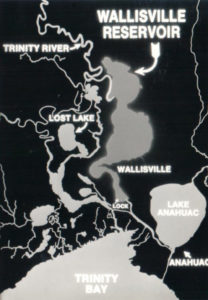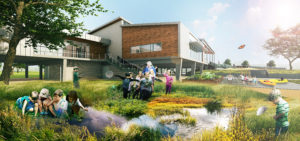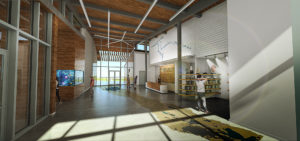“The whole key to the (Galveston Bay Foundation) was bringing different interests together. That was one of the wisdoms of the early founders – to get people in the same room and learn how to talk to other kinds of folks. Otherwise, there would be no successes, and nothing would be accomplished.” – Linda Shead, Galveston Bay Foundation’s first Executive Director, via the Winter 2017 edition of the Galveston Bay Foundation Gazette
For 35 years, the Galveston Bay Foundation has brought together people with diverse interests in Galveston Bay to find creative, inclusive and forward-thinking solutions to the challenges confronting the Bay. Facilitating collaboration among a true cross-section of Bay interests is still very much at the heart of the organization today, even as it has grown to encompass many new programs and large-scale projects.
As the Galveston Bay Foundation turns 35, we look back at the moments that defined its early history, celebrate its recent successes, and look forward to a transformational future that will inspire the next generation of Bay stewards to continue the work of preserving and enhancing Galveston Bay for generations to come!
Shortly after Galveston Bay Foundation’s Articles of Incorporation were officially filed with the state of Texas on July 13, 1987, the newly minted organization began working to tackle two issues of concern.
 The first was known as the Wallisville Project, a proposed dam on the lower Trinity River intended to create a 20,000-acre lake with potentially devastating consequences for the river delta ecosystem downstream. The other was a planned widening and deepening of the Houston Ship Channel with the residual effect of more than 80,000 acres of Bay bottom getting covered by unconfined dredge material. Neither project proceeded as originally envisioned thanks in part to the work of the Galveston Bay Foundation. The Wallisville Project had to be redesigned in 1990 after bald eagles were found nesting in the area. Both the width and depth of the Houston Ship Channel dredge project were later reduced following an economic impact study funded by the foundation.
The first was known as the Wallisville Project, a proposed dam on the lower Trinity River intended to create a 20,000-acre lake with potentially devastating consequences for the river delta ecosystem downstream. The other was a planned widening and deepening of the Houston Ship Channel with the residual effect of more than 80,000 acres of Bay bottom getting covered by unconfined dredge material. Neither project proceeded as originally envisioned thanks in part to the work of the Galveston Bay Foundation. The Wallisville Project had to be redesigned in 1990 after bald eagles were found nesting in the area. Both the width and depth of the Houston Ship Channel dredge project were later reduced following an economic impact study funded by the foundation.
After scoring a pair of early victories, the fledgling organization set its sights on establishing programs that would allow it to fulfill its mission to preserve and enhance Galveston Bay as a healthy and productive place for generations to come. Events and programs that originated in the late 1980s and early 1990s such as large-scale marsh grass plantings and the creation of citizen water monitoring teams laid the foundation for their present-day counterparts. Education programs began to flourish in 1991 following the donation of a 26-foot workboat named the Bay Ranger, and the foundation co-sponsored its first major outreach event – the inaugural Bay Day Festival – that same year.
The implementation of an oil spill response plan and acquisition of Galveston Bay Foundation’s first properties – Shipe Woods, Frost-Dean, and Rich Sanctuary – in 1992 further solidified the organization’s profile as a leader in the environmental conservation field.
Today, the Galveston Bay Foundation has grown from its modest roots to an expansive operation with the ability to support several effective programs that have scaled in capacity to meet the demands of the community and environmental needs surrounding the Bay.
With an emphasis on investing in education as a meaningful way to preserve Galveston Bay for future generations, the foundation has developed one of the most robust environmental education programs of its kind, reaching tens of thousands of students each year through both classroom and field experiences.
Galveston Bay Foundation became an accredited land trust in 2013 and has made steady progress conserving and restoring wetland and coastal prairie habitats that are home to diverse populations of plant and animal species, some of which can only be found in these areas. The land conservation program received a major boost in 2021 with the purchase of the 4,714-acre Chocolate Bay Preserve, the foundation’s largest land acquisition to date. The addition of Chocolate Bay Preserve increased Galveston Bay Foundation’s total amount of critical habitat conserved to just under 14,000 acres.
As the foundation continues to experience exponential growth among all its program areas, it also maintains a commitment to connecting the community to the Bay through a series of outreach, restoration, and fundraising events such as the annual Bay Day Festival, Marsh Mania, Bike Around the Bay, and the inaugural Houston Oyster & SeaFest, which debuted this year. These events and others have allowed volunteers and eventgoers alike to experience the breathtaking diversity of Galveston Bay while taking a proactive hands-on approach in preserving and protecting it for generations to come.
After more than 30 years of leasing office facilities in the Clear Lake area, the Galveston Bay Foundation found a permanent home in 2020 when the organization moved its operations to 30 acres of bay-front property in Kemah.
The foundation purchased the property in 2016 with the intent to one day connect the community to the heart of Galveston Bay – something that otherwise is difficult to do since most of the land around the Bay is privately owned. The current temporary office space will eventually make way for a much grander vision for the site.



Restoration work is already in progress and will continue to transform the property to its original condition. A series of interconnecting trails will showcase several Gulf Coast habitat types including wetlands, trees, and coastal prairie in addition to providing access to the living shoreline near the banks of the Bay.
To learn more about our new headquarters and to be part of the Charting a Course for Galveston Bay Campaign, click here.
